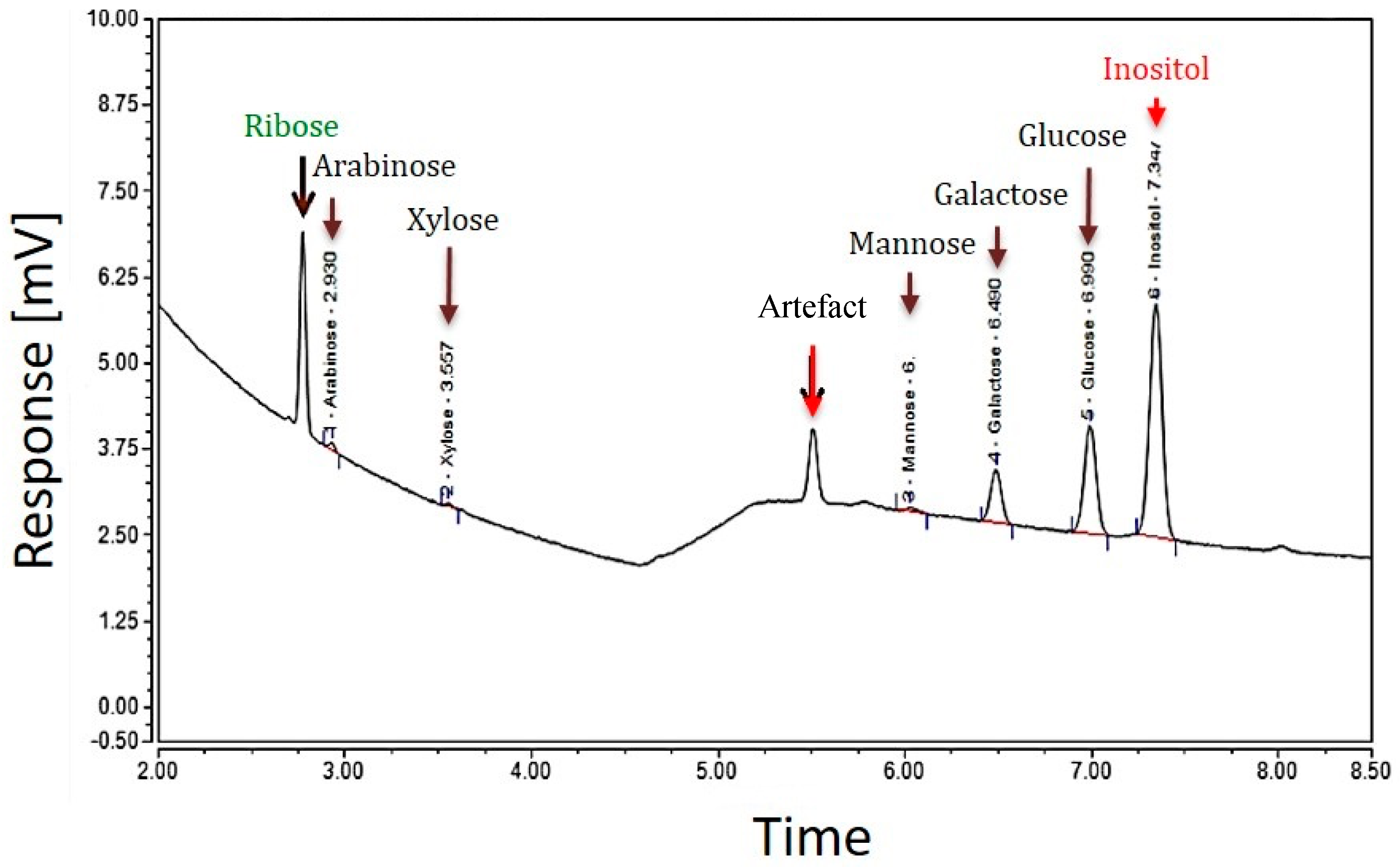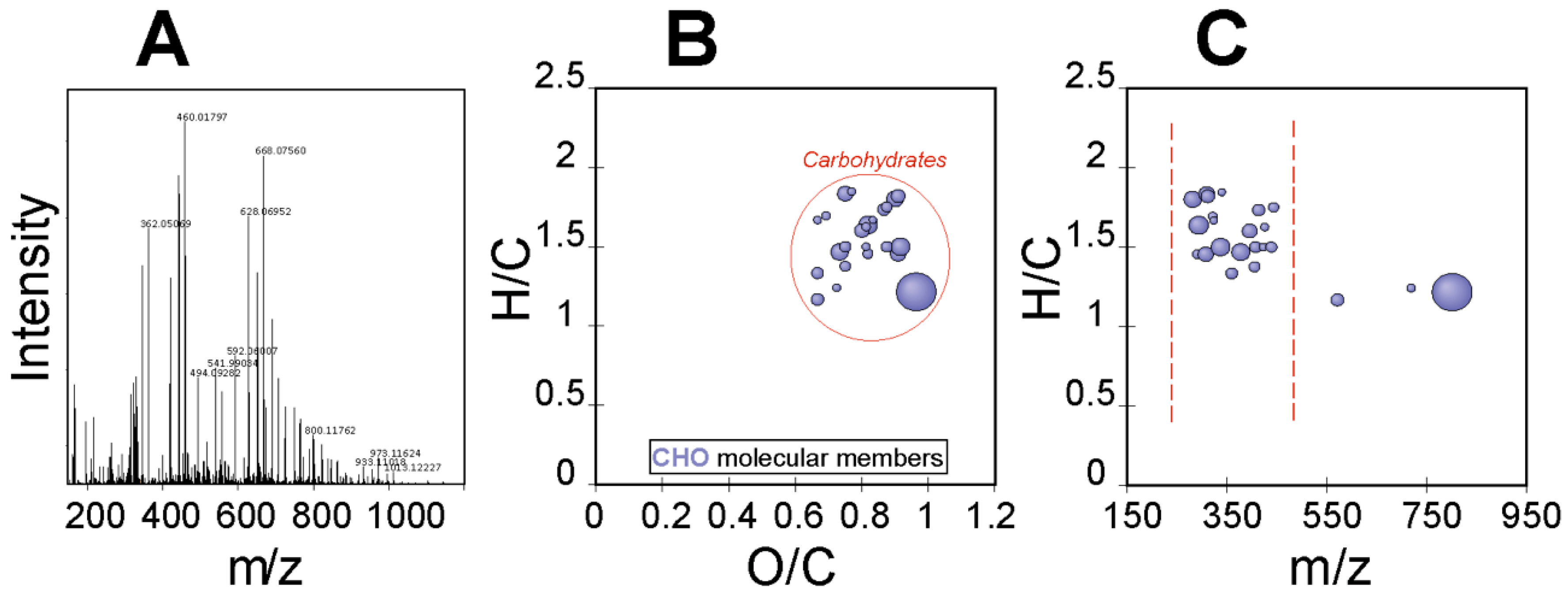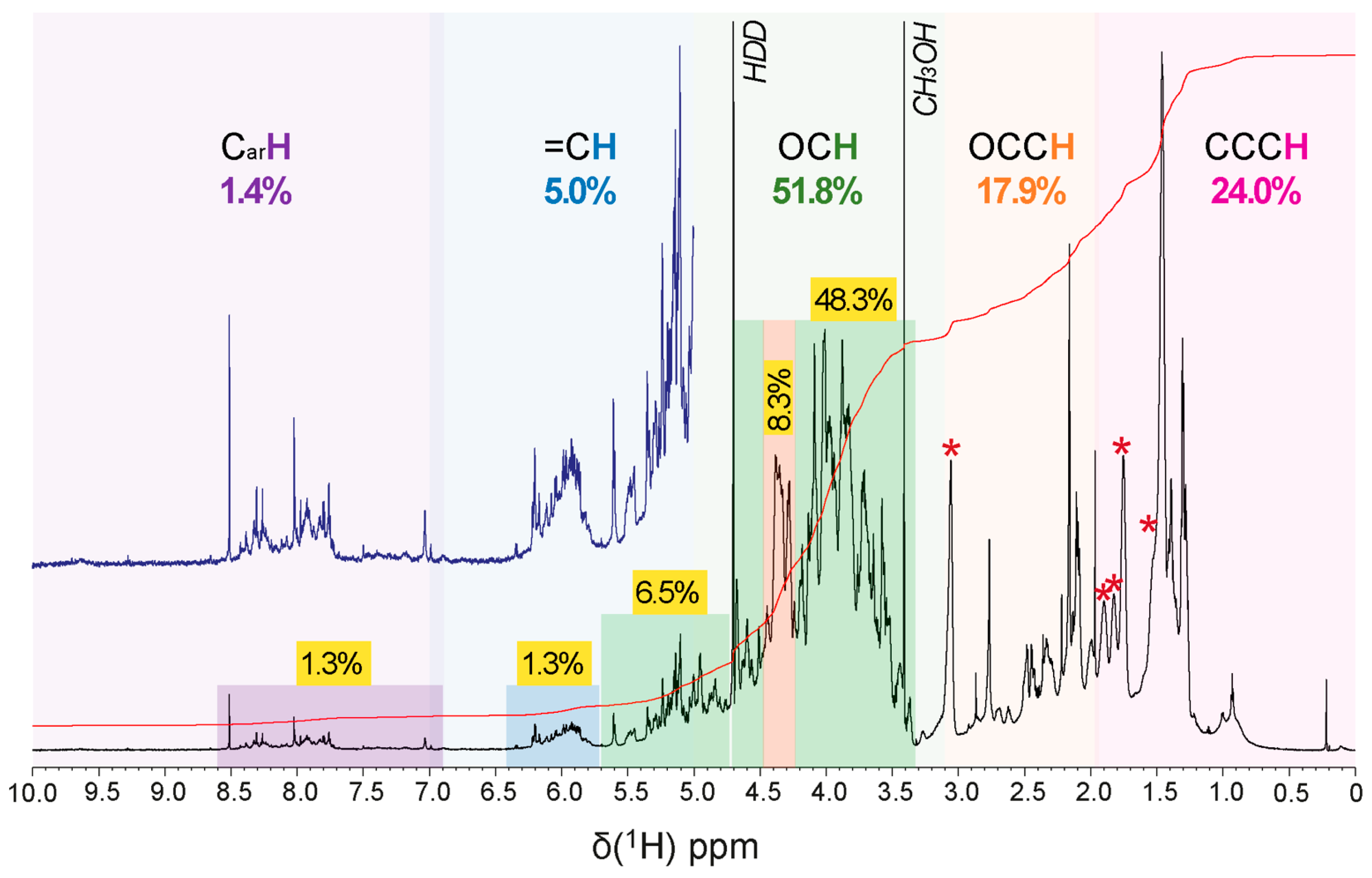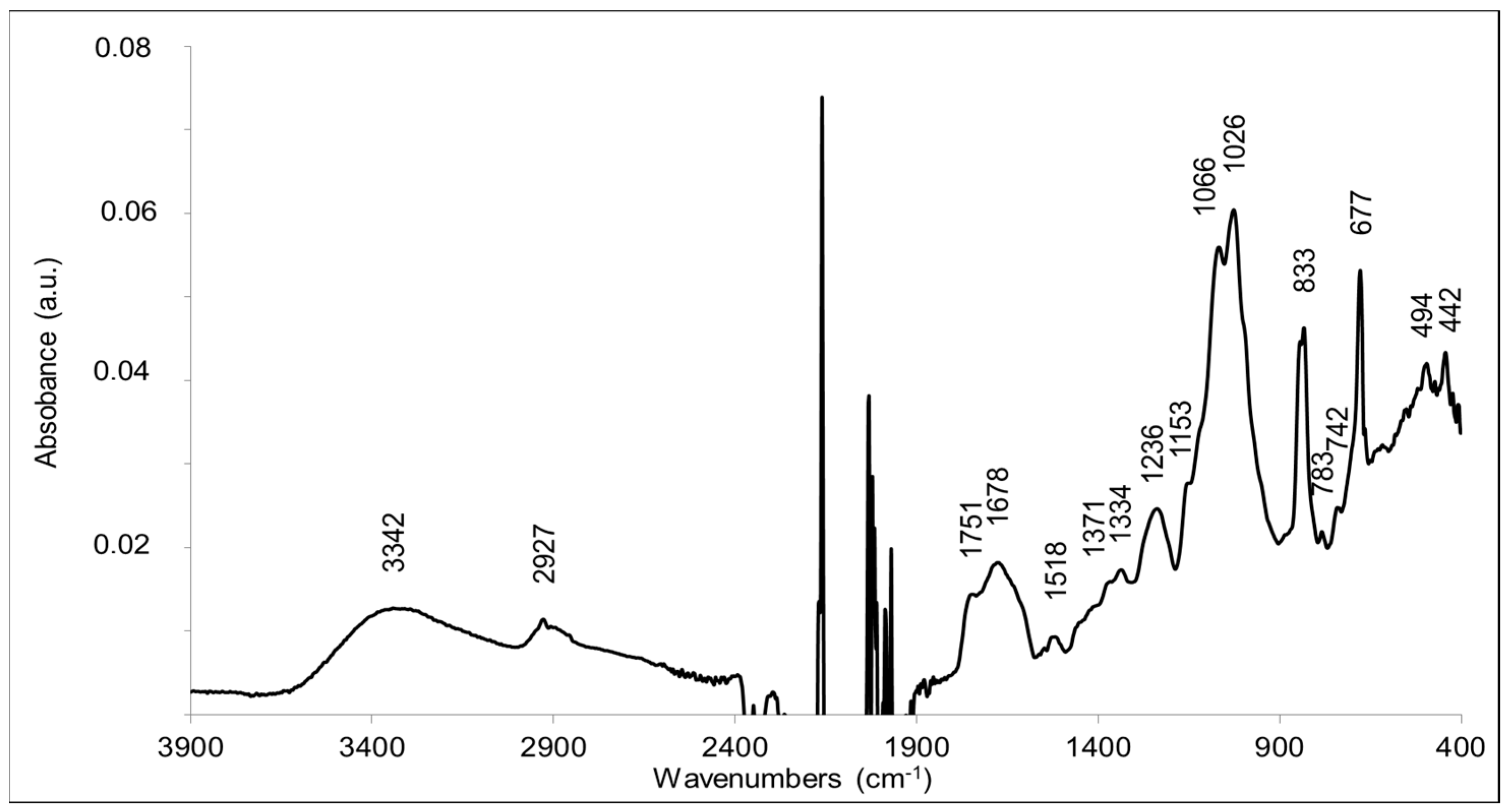Production and Characterization of a Novel Exopolysaccharide from Ramlibacter tataouinensis
Abstract
1. Introduction
2. Results and Discussion
2.1. Optimization of Cyst Formation in Batch Fermentation
2.2. Optimization of Cyst Formation in Fed-Batch Fermentation
2.3. Extraction, Solubility, and Chemical Analysis of EPS
2.4. Monosaccharide Composition and Quantification by GC Analysis
2.5. EPS Polymer Composition and Structural Evaluation by FT-ICR-MS
- Loss of a proton and formation of (M-H)−
- Loss of a proton, dehydration and formation of (M-H2O-H)−
- Loss of a proton, 0.2A fragmentation and formation of (M-C2H4O2-H)−
- Loss of a proton, 0.2A fragmentation, dehydration and formation of (M-C2H4O2-H2O-H)−
2.6. EPS Polymer Composition and Structural Evaluation by FT-ICR-MS
2.7. Analysis of EPS Substituents by FTIR
3. Conclusions
4. Materials and Methods
4.1. Bacterial Strain and Culture Conditions
4.2. Optimization of Cyst Formation by R. tataouinensis TTB310
4.3. Production, Extraction and Purification of EPS from Cysts
4.4. Chemical and Structural Characterizations of the EPS
4.4.1. Chemical Analysis
4.4.2. Fourier-Transform Infrared Spectroscopy (FTIR)
4.4.3. High-Performance Liquid Chromatography (HPLC) Analysis
4.4.4. Gas Chromatography (GC) Analysis of EPS
4.4.5. Fourier Transform Ion Cyclotron Resonance Mass Spectrometry (FT-ICR-MS)
4.4.6. Nuclear Magnetic Resonance (NMR)
Supplementary Materials
Author Contributions
Funding
Institutional Review Board Statement
Informed Consent Statement
Data Availability Statement
Conflicts of Interest
Sample Availability
References
- Rehm, B.H.A. Bacterial polymers: Biosynthesis, modifications and applications. Nat. Rev. Microbiol. 2010, 8, 578–592. [Google Scholar] [CrossRef]
- Suresh Kumar, A.; Mody, K.; Jha, B. Bacterial exopolysaccharides–a perception. J. Basic Microbiol. 2007, 47, 103–117. [Google Scholar] [CrossRef] [PubMed]
- Nwodo, U.; Green, E.; Okoh, A. Bacterial Exopolysaccharides: Functionality and Prospects. Int. J. Mol. Sci. 2012, 13, 14002–14015. [Google Scholar] [CrossRef]
- Freitas, F.; Alves, V.D.; Reis, M.A.M. Advances in bacterial exopolysaccharides: From production to biotechnological applications. Trends Biotechnol. 2011, 29, 388–398. [Google Scholar] [CrossRef] [PubMed]
- Moscovici, M. Present and future medical applications of microbial exopolysaccharides. Front. Microbiol. 2015, 6, 1012. [Google Scholar] [CrossRef] [PubMed]
- Donot, F.; Fontana, A.; Baccou, J.C.; Schorr-Galindo, S. Microbial exopolysaccharides: Main examples of synthesis, excretion, genetics and extraction. Carbohydr. Polym. 2012, 87, 951–962. [Google Scholar] [CrossRef]
- Nicolaus, B.; Kambourova, M.; Oner, E.T. Exopolysaccharides from extremophiles: From fundamentals to biotechnology. Environ. Technol. 2010, 31, 1145–1158. [Google Scholar] [CrossRef] [PubMed]
- Heulin, T.; Barakat, M.; Christen, R.; Lesourd, M.; Sutra, L.; De Luca, G.; Achouak, W. Ramlibacter tataouinensis gen. nov., sp. nov., and Ramlibacter henchirensis sp. nov., cyst-producing bacteria isolated from subdesert soil in Tunisia. Int. J. Syst. Evol. Microbiol. 2003, 53, 589–594. [Google Scholar] [CrossRef]
- Benzerara, K.; Barakat, M.; Menguy, N.; Guyot, F.; De Luca, G.; Audrain, C.; Heulin, T. Experimental colonization and alteration of orthopyroxene by the pleomorphic bacteria Ramlibacter tataouinensis. Geomicrobiol. J. 2004, 21, 341–349. [Google Scholar] [CrossRef]
- Gommeaux, M.; Barakat, M.; Lesourd, M.; Thiéry, J.; Heulin, T. A morphological transition in the pleomorphic bacterium Ramlibacter tataouinensis TTB310. Res. Microbiol. 2005, 156, 1026–1030. [Google Scholar] [CrossRef] [PubMed]
- De Luca, G.; Barakat, M.; Ortet, P.; Fochesato, S.; Jourlin-Castelli, C.; Ansaldi, M.; Py, B.; Fichant, G.; Coutinho, P.M.; Voulhoux, R.; et al. The cyst-dividing bacterium Ramlibacter tataouinensis TTB310 genome reveals a well-stocked toolbox for adaptation to a desert environment. PLoS ONE 2011, 6, e23784. [Google Scholar] [CrossRef] [PubMed]
- Chawla, P.R.; Bajaj, I.B.; Survase, S.A.; Singhal, R.S. Microbial cellulose: Fermentative production and applications. Food Technol. Biotechnol. 2009, 47, 107–124. [Google Scholar]
- Davidson, I.W. Production of polysaccharide by Xanthomonas campestris in continuous culture. FEMS Microbiol. Lett. 1978, 3, 347–349. [Google Scholar] [CrossRef]
- Marczak, M.; Mazur, A.; Koper, P.; Żebracki, K.; Skorupska, A. Synthesis of rhizobial exopolysaccharides and their importance for symbiosis with legume plants. Genes 2017, 8, 360. [Google Scholar] [CrossRef] [PubMed]
- Ozturk, S.; Aslim, B. Modification of exopolysaccharide composition and production by three cyanobacterial isolates under salt stress. Environ. Sci. Pollut. Res. 2010, 17, 595–602. [Google Scholar] [CrossRef]
- Górska-Frączek, S.; Sandström, C.; Kenne, L.; Rybka, J.; Strus, M.; Heczko, P.; Gamian, A. Structural studies of the exopolysaccharide consisting of a nonasaccharide repeating unit isolated from Lactobacillus rhamnosus KL37B. Carbohydr. Res. 2011, 346, 2926–2932. [Google Scholar] [CrossRef] [PubMed]
- Roca, C.; Alves, V.D.; Freitas, F.; Reis, M.A.M. Exopolysaccharides enriched in rare sugars: Bacterial sources, production, and applications. Front. Microbiol. 2015, 6, 288. [Google Scholar] [CrossRef]
- Fraysse, N.; Lindner, B.; Kacynski, Z.; Sharypova, L.; Holst, O.; Niehaus, K.; Poinsot, V. Sinorhizobium meliloti strain 1021 produces a low-molecular-mass capsular polysaccharide that is a homopolymer of 3-deoxy-D-manno-oct-2-ulosonic acid harboring a phospholipid anchor. Glycobiology 2004, 15, 101–108. [Google Scholar] [CrossRef]
- Garozzo, D.; Giuffrida, M.; Impallomeni, G.; Ballistreri, A.; Montaudo, G. Determination of linkage position and identification of the reducing end in linear oligosaccharides by negative-ion fast atom bombardment mass-spectrometry. Anal. Chem. 1990, 62, 279–286. [Google Scholar] [CrossRef]
- Lundqvist, L. Structural and Interaction Studies of Polysaccharides by NMR Spectroscopy; Diss. (sammanfattning/summary); Sveriges lantbruksuniv; Acta Universitatis Agriculturae Sueciae: Uppsala, Sweden, 2015. [Google Scholar]
- Glushka, J.N.; Terrell, M.; York, W.S.; O’Neill, M.A.; Gucwa, A.; Darvill, A.G.; Albersheim, P.; Prestegard, J.H. Primary structure of the 2-O-methyl-α-l-fucose-containing side chain of the pectic polysaccharide, rhamnogalacturonan II. Carbohydr. Res. 2003, 338, 341–352. [Google Scholar] [CrossRef]
- Ravenscroft, N.; Cescutti, P.; Gavini, M.; Stefanetti, G.; MacLennan, C.A.; Martin, L.B.; Micoli, F. Structural analysis of the O-acetylated O-polysaccharide isolated from Salmonella paratyphi A and used for vaccine preparation. Carbohydr. Res. 2015, 404, 108–116. [Google Scholar] [CrossRef] [PubMed][Green Version]
- van den Bulk, R.W.; Zevenhuizen, L.P.T.M.; Cordewener, J.H.G.; Dons, J.J.M. Characterization of the extracellular polysaccharide produced by Clavibacter michiganensis supsp. michiganensis. Phytopathology 1991, 81, 619–623. [Google Scholar] [CrossRef]
- Lahaye, M.; Ray, B. Cell-wall polysaccharides from the marine green alga Ulva “rigida” (Ulvales, Chlorophyta)-NMR analysis of ulvan oligosaccharides. Carbohydr. Res. 1996, 283, 161–173. [Google Scholar] [CrossRef]
- Haverkamp, J.; Van Halbeek, H.; Dorland, L.; Vliegenthart, J.F.G.; Pfeil, R.; Schauer, R. High-resolution 1H-NMR spectroscopy of free and glycosidically linked O-acetylated sialic acids. Eur. J. Biochem. 1982, 122, 305–311. [Google Scholar] [CrossRef]
- Orgambide, G.G.; Philip-Hollingsworth, S.; Dazzo, F.B.; Tola, E.; Squartini, A.; Nuti, M.P.; Cedergren, R.A.; Hollingsworth, R.I. Glycoconjugate and lipid components of Rhizobium “hedysari” IS123, a root-nodule symbiont of the stress-tolerant legume Hedysarum coronarium. Can. J. Microbiol. 1996, 42, 340–345. [Google Scholar] [CrossRef][Green Version]
- He, Y.; Ye, M.; Du, Z.; Wang, H.; Wu, Y.; Yang, L. Purification, characterization and promoting effect on wound healing of an exopolysaccharide from Lachnum YM405. Carbohydr. Polym. 2014, 105, 169–176. [Google Scholar] [CrossRef]
- Ogawa, K.; Yamaura, M.; Maruyama, I. Isolation and identification of 2-O-methyl-l-rhamnose and 3-O-methyl-l-rhamnose as constituents of an acidic polysaccharide of Chlorella vulgaris. Biosci. Biotechnol. Biochem. 1997, 61, 539–540. [Google Scholar] [CrossRef]
- Gromska, W.; Mayer, H. The linkage of lysine in the O-specific chains of Proteus mirabilis 1959. Eur. J. Biochem. 1976, 62, 391–399. [Google Scholar] [CrossRef]
- Shashkov, A.S.; Toukach, F.V.; Paramonov, N.A.; Ziolkowski, A.; Senchenkova, S.N.; Kaca, W.; Knirel, Y.A. Structures of new acidic O-specific polysaccharides of the bacterium Proteus mirabilis serogroups O26 and O30. FEBS Lett. 1996, 386, 247–251. [Google Scholar] [CrossRef]
- Neszmélyi, A.; Kosma, P.; Christian, R.; Schulz, G.; Unger, F.M. Empirical 13C-n.m.r.-correlations between the Escherichia coli K13 and LP1092 capsular polysaccharides and model oligosaccharides containing D-ribose and 3-deoxy-D-manno-2-octulosonic acid. Carbohydr. Res. 1985, 139, 13–22. [Google Scholar] [CrossRef]
- Sathiyanarayanan, G.; Bhatia, S.K.; Kim, H.J.; Kim, J.H.; Jeon, J.M.; Kim, Y.G.; Park, S.H.; Lee, S.H.; Lee, Y.K.; Yang, Y.H. Metal removal and reduction potential of an exopolysaccharide produced by Arctic psychrotrophic bacterium Pseudomonas sp. PAMC 28620. RSC Adv. 2016, 6, 96870–96881. [Google Scholar] [CrossRef]
- Sathiyanarayanan, G.; Yi, D.H.; Bhatia, S.K.; Kim, J.H.; Seo, H.M.; Kim, Y.G.; Park, S.H.; Jeong, D.; Jung, S.; Jung, J.Y.; et al. Exopolysaccharide from psychrotrophic Arctic glacier soil bacterium Flavobacterium sp. ASB 3-3 and its potential applications. RSC Adv. 2015, 5, 84492–84502. [Google Scholar] [CrossRef]
- Cestelli Guidi, M.; Mirri, C.; Fratini, E.; Licursi, V.; Negri, R.; Marcelli, A.; Amendola, R. In vivo skin leptin modulation after 14 MeV neutron irradiation: A molecular and FT-IR spectroscopic study. Anal. Bioanal. Chem. 2012, 404, 1317–1326. [Google Scholar] [CrossRef] [PubMed]
- Kazy, S.K.; Sar, P.; Singh, S.P.; Sen, A.K.; D’Souza, S.F. Extracellular polysaccharides of a copper-sensitive and a copper-resistant Pseudomonas aeruginosa strain: Synthesis, chemical nature and copper binding. World J. Microbiol. Biotechnol. 2002, 18, 583–588. [Google Scholar] [CrossRef]
- Xiaoyan, L.; Qiang, W.; Xuegang, L.; Feng, L.; Xiaoqing, L.; Pan, H. Effect of degree of acetylation on thermoplastic and melt rheological properties of acetylated konjac glucomannan. Carbohydr. Polym. 2010, 82, 167–172. [Google Scholar] [CrossRef]
- Kovacs, A.; Nyerges, B.; Izvekov, V. Vibrational analysis of N-acetyl-α-D-glucosamine and β-D-glucuronic acid. J. Phys. Chem. B 2008, 112, 5728–5735. [Google Scholar] [CrossRef]
- Burie, J.R.; Boullais, C.; Nonella, M.; Mioskowski, C.; Nabedryk, E.; Breton, J. Importance of the conformation of methoxy groups on the vibrational and electrochemical properties of ubiquinones. J. Phys. Chem. B 1997, 101, 6607–6617. [Google Scholar] [CrossRef]
- Liu, X.; Renard, C.M.G.C.; Bureau, S.; Le Bourvellec, C. Revisiting the contribution of ATR-FTIR spectroscopy to characterize plant cell wall polysaccharides. Carbohydr. Polym. 2021, 262, 117935. [Google Scholar] [CrossRef] [PubMed]
- Copikova, J.; Barros, A.S.; Smidova, I.; Cerna, M.; Texeira, D.H.; Delgadillo, I.; Synytsya, A.; Coimbra, M.A. Influence of hydration of food additive polysaccharides on FT-IR spectra distinction. Carbohydr. Polym. 2006, 63, 355–359. [Google Scholar] [CrossRef]
- Tarek, A.A.; Dalia, M.; Ali, M.I. Isolation and identification of novel disaccharide of κ-L-rhamnose from Penicillium chrysogenum. World Appl.Sci. J. 2008, 3, 476–486. [Google Scholar]
- Barker, S.A.; Bourne, E.J.; Stacey, M.; Whiffen, D.H. Infra-red spectra of carbohydrates. Part I. Some derivatives of D-glucopyranose. J. Chem. Soc. 1954, 171–176. [Google Scholar] [CrossRef]
- Kacurakova, M.; Belton, P.S.; Wilson, R.H.; Hirsch, J.; Ebringerova, A. Hydration properties of xylan-type structures: An FTIR study of xylooligosaccharides. J. Sci. Food Agric. 1998, 77, 38–44. [Google Scholar] [CrossRef]
- Hay, I.D.; Ur Rehman, Z.; Moradali, M.F.; Wang, Y.; Rehm, B.H. Microbial alginate production, modification and its applications. Microb. Biotechnol. 2013, 6, 637–650. [Google Scholar] [CrossRef] [PubMed]
- Jeong, J.P.; Kim, Y.; Hu, Y.; Jung, S. Bacterial succinoglycans: Structure, physical properties, and applications. Polymers 2022, 14, 276. [Google Scholar] [CrossRef]
- Dubois, M.; Gilles, K.A.; Hamilton, J.K.; Rebers, P.A.; Smith, F. Colorimetric method for determination of sugars and related substances. Anal. Chem. 1956, 28, 350–356. [Google Scholar] [CrossRef]
- Blumenkrantz, N.; Asboe-Hansen, G. New method for quantitative determination of uronic acids. Anal. Biochem. 1973, 54, 484–489. [Google Scholar] [CrossRef]







Publisher’s Note: MDPI stays neutral with regard to jurisdictional claims in published maps and institutional affiliations. |
© 2022 by the authors. Licensee MDPI, Basel, Switzerland. This article is an open access article distributed under the terms and conditions of the Creative Commons Attribution (CC BY) license (https://creativecommons.org/licenses/by/4.0/).
Share and Cite
Jivkova, D.; Sathiyanarayanan, G.; Harir, M.; Hertkorn, N.; Schmitt-Kopplin, P.; Sanhaji, G.; Fochesato, S.; Berthomieu, C.; Heyraud, A.; Achouak, W.; et al. Production and Characterization of a Novel Exopolysaccharide from Ramlibacter tataouinensis. Molecules 2022, 27, 7172. https://doi.org/10.3390/molecules27217172
Jivkova D, Sathiyanarayanan G, Harir M, Hertkorn N, Schmitt-Kopplin P, Sanhaji G, Fochesato S, Berthomieu C, Heyraud A, Achouak W, et al. Production and Characterization of a Novel Exopolysaccharide from Ramlibacter tataouinensis. Molecules. 2022; 27(21):7172. https://doi.org/10.3390/molecules27217172
Chicago/Turabian StyleJivkova, Desislava, Ganesan Sathiyanarayanan, Mourad Harir, Norbert Hertkorn, Philippe Schmitt-Kopplin, Ghislain Sanhaji, Sylvain Fochesato, Catherine Berthomieu, Alain Heyraud, Wafa Achouak, and et al. 2022. "Production and Characterization of a Novel Exopolysaccharide from Ramlibacter tataouinensis" Molecules 27, no. 21: 7172. https://doi.org/10.3390/molecules27217172
APA StyleJivkova, D., Sathiyanarayanan, G., Harir, M., Hertkorn, N., Schmitt-Kopplin, P., Sanhaji, G., Fochesato, S., Berthomieu, C., Heyraud, A., Achouak, W., Santaella, C., & Heulin, T. (2022). Production and Characterization of a Novel Exopolysaccharide from Ramlibacter tataouinensis. Molecules, 27(21), 7172. https://doi.org/10.3390/molecules27217172






